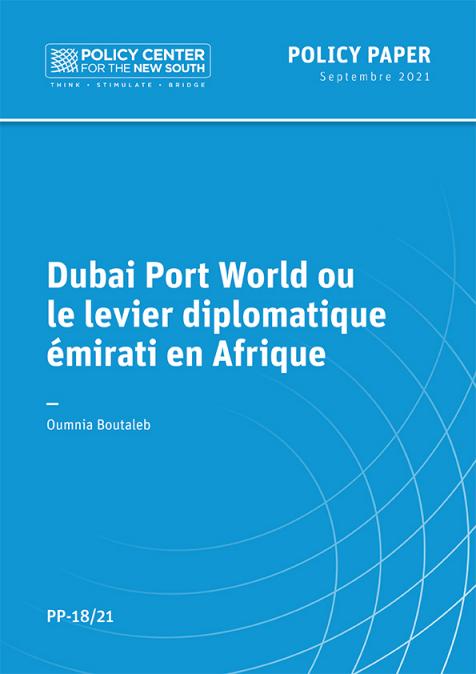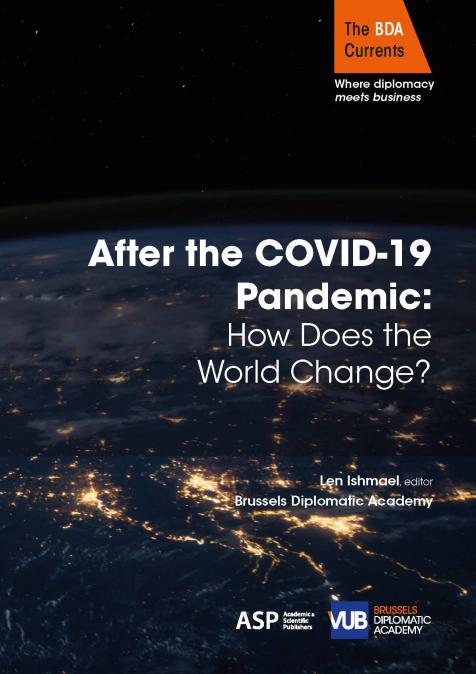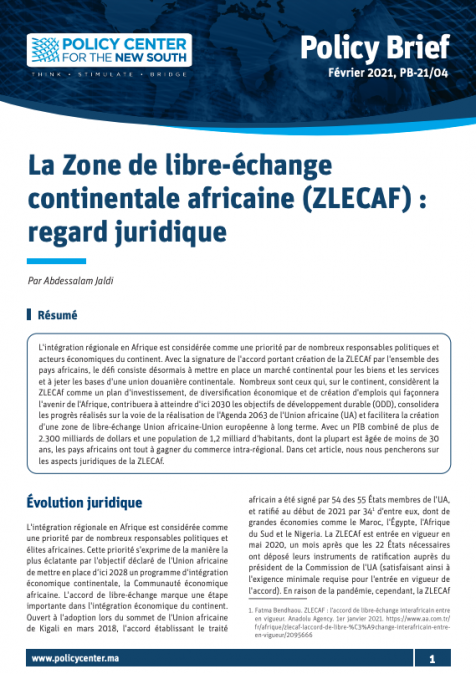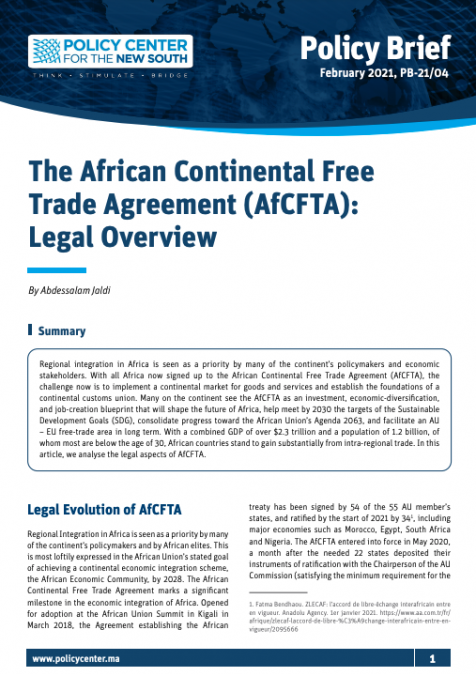Publications /
Opinion
The agreement establishing the African Continental Free Trade Area (AfCFTA) is a framework to create a free trade area across the region, bringing together the 55 members of the African Union into a continental market with a cumulative Gross Domestic Product (GDP) exceeding US$2.2 trillion and a total population of over one billion people. When concluded and successfully implemented, it will become the largest free trade area in the world in terms of membership, opening up significant opportunities for people and firms from the region and beyond. In signing the AfCFTA, African leaders have taken a very bold step. To convert their vision and political will into a full-fledged agreement that delivers on its promise will require hard work and tough decisions, in particular to maximize impact, bring many Africans to benefit and make the agreement work.
The AfCFTA sets the objectives, principles, institutions and work plan to complete a negotiating process, which must encompass the following: the progressive elimination of tariffs and non-tariff barriers to trade in goods and services as well as cooperation on investment, intellectual property rights, competition policy & other trade-related areas, and the establishment of a dispute settlement mechanism. Protocols on trade in goods, services and dispute settlement have already been completed and annexed to the framework; the negotiation of tariff concessions and rules of origin, as well as specific commitments to liberalize services trade is ongoing, while protocols on other topics are reserved for a second phase of negotiations. The AfCFTAis expected to come into force by early 2019, with ratification by at least 22 countries1.
The AfCFTA is a remarkable achievement on at least two fronts. First, among the challenges confronting global trade governance today, it is uplifting to have positive energy on regional trade integration coming from other corners of the world. Second, it is refreshing to confirm that the AfCFTA is set on a broader quest for increased growth, enhanced competitiveness, improved business climate, greater investment, strengthened industrialization and export diversification, and development of regional and continental global value chains. This is the type of regional integration – opened to the world – that is required for AfCFTA to operate as a building block for further participation of African countries in the global economy.
While integration between Sub-Saharan countries has deepened through trade, the potential for growth is significant. Regional exports have increased from 6 percent of total exports in 1980 (1 percent of GDP) to 20 percent in 2016 (4 percent of GDP), which is in line with other emerging and developing regions (Figure 1). However, most of this trade takes place among countries within sub-regions, in particular in the East African Community (EAC) and the Southern African Development Community (SADC), and not between regions2. Further integration would bring important benefits. A recent study finds that a 1 percent increase in the weighted growth rate of intra-regional partners is associated with an increase of 0.11 in domestic growth3.
Figure 1 - Sub-Saharan Africa: Intraregional Trade, Percent of GDP, 1980–2016

Broad and successful implementation of the AfCFTA can support increased intra-African trade integration, unlocking a driver of growth for the region. To fully leverage its potential, specific actions are required to maximize impact of the agreement, bring many Africans to benefit from it, and make sure that it actually would work.
Maximize impact
Broad membership in the AfCFTA is fundamental to expand its benefits. When launched in March 2018, 44 countries signed the agreement. At the time, Nigeria, South Africa, Botswana and Zambia, among others, were missing. Simulations from the World Bank show that, without them, the signatories trade less than 5 percent regionally, compared with 25 percent for Sub-Saharan Africa as a whole4. Since then, five more countries, including South Africa, have signed the agreement; Nigeria and others have indicated their interest to join. Expectation is that all will come on board.
For the AfCFTA to deliver, the schedule of concessions –which is in the process of being negotiated- needs to provide for liberalization of trade in goods. The main conclusion of a new report by the Sweden National Trade Board, based on a survey of empirical studies, is that it is when countries make commitments – not when they avoid them by supporting their defensive interests – that regional trade agreements help them increase trade5.
A recent paper by Berahab and Dadush make a strong case for limiting product exceptions6. In a recent simulation by the United Nations Conference on Trade and Development (UNCTAD), exemptions of 5-10 percent of tariff lines could effectively exclude almost all trade between African countries and cut overall benefits by more than half7. Liberal rules of origin are an indispensable complement to an ambitious tariff elimination schedule . Reducing non-tariff barriers and harmonizing regulatory measures that outweigh the impact of tariffs is key, as intra-African trade is frequently hampered by permits and licenses for exports and imports, difference in standards and the procedures of customs and other border agencies. Monitoring and disciplining these barriers is necessary to facilitate trade9.
There are two additional points, which require careful treatment in the negotiation. The Protocol of Trade in Goods to the AfCFTA contains a provision that allows parties to impose measures for protecting infant industries (Article 24). This norm is widely crafted and could very well negate the main objectives of the agreement. Another provision of the same protocol indicates that the parties will develop rules to govern trade of products manufactured in special economic zones (Article 23). This is also an important topic if the AfCFTA is to support the development of supply chains.
If the vast opportunities for increased regional trade are to be realized, commitments to open services markets are of essence. Not only is there great potential for trade in services in Sub-Saharan Africa, but also improved services are essential to facilitate trade in goods10. The Protocol on Trade in Services envisions a list of priority sectors for negotiation; additional clarity is required as to the modalities for the negotiation of specific commitments. Ideally, a negative list approach would be followed, even if negotiations proceed by sectors. To avoid negating the benefits of increased services liberalization, a provision in the protocol providing great leeway for parties to use subsidies in relation to develop programs (Article 17) is to be threaded carefully.
Bring many Africans to benefit
Two out of three people in extreme poverty in the world today live in Sub-Saharan Africa; if current trends continue, by 2030 nine out of ten will11. To contribute to the fight against poverty, the AfCFTA must put poverty reduction at the heart of the negotiations. Evidence shows that trade can benefit the poor by spurring economic growth, which in turn is the most powerful tool for poverty alleviation, reducing prices and bringing greater diversification and macroeconomic stability. It can also bring risks, which must be addressed and mitigated12.
For the poor to benefit from the AfCFTA, three points must be highlighted. First, as discussed by Berahab and Dadush, negotiations should prioritize for early liberalization products that can provide a natural ladder for diversification in Africa, including labor intensive manufactures and agricultural products in which Africans have or could develop a comparative advantage13. Fostering regional value chains would require immediate liberalization of intermediate goods and more broadly, facilitation of intermediate trade14; it also provides a strong rationale for opening and putting in place appropriate regulatory frameworks for services industries that are key for competitiveness in both manufacturing and agriculture, including transportation and logistics, finance and telecommunications, among others. In the second phase of the AfCFTA negotiations, the rules on investment, competition policy and intellectual property should support supply chains across the continent.
Second, limiting exclusions on food products is critical. World Bank research has shown that significant regulatory barriers to trade undermine the potential for food trade in the region, including trade barriers limiting access to seeds, fertilizers, extension services and other inputs; high transport costs; opaque and unpredictable trade policies; cross-border obstacles; and inefficient distribution services15. Though the solution to food insecurity in Africa goes well beyond theAfCFTA, the agreementhas the potential to make a strong contribution to address the bottlenecks that hinder trade along the food supply chain.
Third, improved transport infrastructure and logistics, as well as expedited and secure customs procedures and cross-border management, are needed to maximize the continent’s potential gains from trade. The high cost of getting goods to and from borders or ports increases trade costs, which in turn limits the potential of remote locations to benefit from trade16. One important point to mention is that the particular situation of informal cross-border traders, most of which are poor women, is to be facilitated. The EAC and the Common Market for East and Southern Africa (COMESA) have adopted simplified trade regimes for small-scale cross-border traders, which could inform the AfCFTA17.Additional policies that help connect the poor to markets, for example, through vigorous competition in key sectors, would allow for wider dissemination of trade gains, including to the poor18.
Make it Work
Effective implementation of the AfCFTA will need an adequate institutional underpinning to make it work. This would require technical assistance and cooperation to continue to build specialized capacity in the trade-related public sector institutions, including ministries of trade, industry and economy, as well as customs and other cross-border trade-related agencies, as well as to foster alignment, effectiveness and intra-agency coordination at both the national and regional levels. Strong and modern export and investment promotion agencies to support internationalization of domestic firms and attract investment complement this institutional cluster.
An active and informed private sector is critical for the AfCFTA to deliver. Broad dissemination and identification of new market access openings, as well as strengthening of capacity to leverage those opportunities, including by young and high growth firms, women, farmers and others, could put the agreement to work for the benefit of Africans.
One interesting point is that the AfCFTA also brings good ideas to the rest of the world-beyond Africa. To solve trade conflicts, the agreement provides for a strong dispute settlement mechanism, modeled after the system in the World Trade Organization (WTO). One important difference, however, is that should the Dispute Settlement Body (DSB) established by the agreements fail to appoint a person to fill an Appellate Body vacancy, the DSB Chairperson shall fill the vacancy within one month. A similar rule would come in handy to solve the dispute settlement crisis confronting the WTO today!
***
Many African countries are small and their markets highly fragmented. In Sub-Saharan Africa, in particular, over 70 percent of countries have a population of less than 20 million, and about half have a GDP of less than $10 billion, with about one third of countries landlocked. This results in diseconomies of scale, which pull down the economic potential of the whole continent.19 The case for regional integration is thus strong. In the midst of increased global uncertainty and frictions, and prospects for modest growth in the region, the rational for leveraging the opportunity of AfCFTA’s becomes even more compelling.
Anabel Gonzalez is consultant on trade, investment and economic development; former Trade Minister of Costa Rica; former World Bank Trade & Competitiveness Global Practice Senior Director.
1 Tradescape. 2018. The AfCFTA Agreement is set to enter into force by early 2019. https://www.tralac.org/news/article/13349-tradescape-the-afcfta-agreemen...
2 Francisco Arizala, MatthieuBellon, Margaux MacDonald, Montfort Miachila, and Mustafa Yenice. 2018. Regional spillovers in Sub-Saharan Africa : exploring different channels. International Monetary Fund. Washington, DC. http://www.imf.org/en/Publications/Spillover-Notes/Issues/2018/08/01/Reg...
3 IBID
4 The World Bank Group. 2018. Africa Trade Seminar: Africa in the New Trade Environment: A Research Agenda. Washington, DC. https://www.worldbank.org/en/events/2018/06/12/africa-trade-seminar-afri...
5 NationalBoard of TradeSweden. 2018. EconomicIntegration Works – TheTradeEffects of Regional TradeAgreements. Stockholm. https://www.kommers.se/Documents/dokumentarkiv/publikationer/2018/publ-e...
6 Rim Berahab and Uri Dadush. 2018. WilltheAfrican Free TradeAgreementSucceed?, OCP Policy Brief, PB-18/10. http://www.ocppc.ma/publications/will-african-free-trade-agreement-succeed
7 Mesut Saygili, Ralf Peters and Christian Knebel. 2018. Africa Continental Free Trade Area: Challenges and Opportunities of Tariff Reductions, UNCTAD Research Paper No. 15 UNCTAD/SER.RP/2017/15. Geneva. http://unctad.org/en/PublicationsLibrary/ser-rp-2017d15_en.pdf
8 Berahab and Dadush.
9 David Vanzetti, Ralf Peters and Christian Knebel. 2018. Non-tariff measures: lifting CFTA and ACP trade to the next level, UNCTAD Research Paper No. 14 UNCTAD/SER.RP/2017/14. Geneva. http://unctad.org/en/PublicationsLibrary/ser-rp-2017d14_en.pdf
10 Nora Dihel and Arti Grover Goswami. 2016. From Hair Stylists and Teachers to Accountants and Doctors The Unexplored Potential of Trade in Services in Africa. The World Bank Group. Washington, DC. http://documents.worldbank.org/curated/en/477321469182630728/pdf/107185-...
11 HomiKharas, Kristopher Hamel and Martin Hofer. 2018. The Start of a New Poverty Narrative, Brookings. Washington, DC. https://www.brookings.edu/blog/future-development/2018/06/19/the-start-o...
12 The World Bank Group and World Trade Organization. 2015. The Role of Trade in Ending Poverty. Geneva. https://www.wto.org/english/res_e/booksp_e/worldbankandwto15_e.pd
13 Berahab and Dadush.
14 David Luke and Lily Sommer. 2018. How to ensure Africa’s bold free trade area propels industrialization. African Arguments. http://africanarguments.org/2018/04/10/how-to-ensure-africa-bold-free-tr...
15 The World Bank Group. 2012. African can HelpFeedAfrica – RemovingBarriers to Regional Trade in Food Staples. Washington, DC. http://siteresources.worldbank.org/INTAFRICA/Resources/Africa-Can-Feed-A...
16 Dave Donaldson, Amanda Jinhage, and Eric Verhoogen. 2017. Beyondborders: MakingtransportworkforAfricanTrade, The International Growth Center. https://www.theigc.org/wp-content/uploads/2017/03/TransportGrowthBrief_F...
17 International Centre forTrade and SustainableDevelopment. 2018. A Look at theSimplifiedTradeRegimes in East and SouthernAfrica, Bridges Africa, Volume 7 – Number 4. Geneva. https://www.ictsd.org/bridges-news/bridges-africa/news/a-look-at-the-sim...
18 The World Bank Group. 2016. Breaking Down Barriers: Unlocking Africa's Potential through Vigorous Competition Policy. Washington, DC. http://documents.worldbank.org/curated/en/243171467232051787/pdf/106717-...










